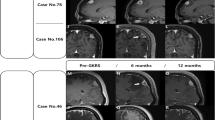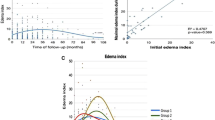Abstract
Introduction
Intraventricular trigonal meningiomas (ITM) seem to have a tendency for extensive perifocal edema formation following radiosurgery (RS). To further investigate this hypothesis, we undertook the following study.
Methods
We retrospectively reviewed records of patients who underwent RS for intraventricular meningiomas at our institution.
Results
From 1999 until 2019, 5 patients underwent single-session RS as primary treatment for ITM. Patients were treated either with a Gamma Knife or a CyberKnife. The mean prescription dose (PD) was 13.0 Gy ± 0.9, the mean tumor volume was 5.8 cc ± 3.1, and the mean follow-up (FU) was 8.9 years ± 5.6. Perifocal edema developed in 4/5 patients after a mean interval of 6.4 months ± 1.2. It was symptomatic in 2/5 patients. The edema regressed spontaneously in 4/5 patients. One of the patients underwent RS for the same ITM twice. One patient’s edema was treated medically with steroids, and none of the patients underwent surgery following RS.
Conclusion
Even though the number of patients is low, there seems to be a comparably high risk for the formation of a perifocal edema following RS for ITM. Single-session RS as primary treatment for ITM seems to be safe and effective even though a perifocal edema is likely to develop. The perifocal edema and the ensuing neurological deficits were transient and could be managed conservatively in all of our 5 cases.




Similar content being viewed by others
References
Chang JH, Chang JW, Choi JY, Chung SS (2003) Complications after gamma knife radiosurgery for benign meningiomas. J Neurol Neurosurg Psychiatry 74:226–230
Ding D, Xu Z, McNeill IT, Yen C-P, Sheehan JP (2013) Radiosurgery for parasagittal and parafalcine meningiomas. J Neurosurg 119:871–877
Kaul D, Badakhshi H, Gevaert T, Pasemann D, Budach V, Tuelaesca C, Gruen A, Prasad V, Levivier M, Kufeld M (2015) Dosimetric comparison of different treatment modalities for stereotactic radiosurgery of meningioma. Acta Neurochir 157:559–564
Mansouri A, Larjani S, Klironomos G, Laperriere N, Cusimano M, Gentili F, Schwartz M, Zadeh G (2015) Predictors of response to Gamma Knife radiosurgery for intracranial meningiomas. J Neurosurg 123(5):1294–1300
Nundkumar N, Guthikonda M, Mittal S (2013) Peritumoral edema following Gamma Knife radiosurgery as the primary treatment for intraventricular meningiomas. J Clin Neurosci 20:616–618
Paddick I (2000) A simple scoring ratio to index the conformity of radiosurgical treatment plans. J Neurosurg (Suppl 3):219–222
Paddick I, Lippitz B (2006) A simple dose gradient measurement tool to complement the conformity index. J Neurosurg 105(Suppl):194–201
Torrens M, Chung C, Chung H-T, Hanssens P, Jaffray D, Kemeny A, Larson D, Levivier M, Lindquist C, Lippitz B, Novotny J, Paddick I, Prasad D, Yu CP (2014) Standardization of terminology in stereotactic radiosurgery: report from the Standardization Committee of the International Leksell Gamma Knife Society. J Neurosurg 121(Suppl 2):2–15
Author information
Authors and Affiliations
Corresponding author
Ethics declarations
Conflict of interest
All authors certify that they have no affiliations with or involvement in any organization or entity with any financial interest (such as honoraria; educational grants; participation in speakers’ bureaus; membership, employment, consultancies, stock ownership, or other equity interest; and expert testimony or patent-licensing arrangements), or non-financial interest (such as personal or professional relationships, affiliations, knowledge, or beliefs) in the subject matter or materials discussed in this manuscript.
Ethical approval
All procedures performed in studies involving human participants were in accordance with the ethical standards of the institutional and/or national research committee (Kantonale Ethikkommission Zürich) and with the 1964 Helsinki declaration and its later amendments or comparable ethical standards. For this type of study, formal consent or formal ethical approval is not required.
Additional information
Publisher’s note
Springer Nature remains neutral with regard to jurisdictional claims in published maps and institutional affiliations.
This article is part of the Topical Collection on Brain Tumors
Rights and permissions
About this article
Cite this article
Mindermann, T., Heckl, S. & Mack, A. High incidence of transient perifocal edema following upfront radiosurgery for intraventricular meningiomas. Acta Neurochir 162, 2177–2182 (2020). https://doi.org/10.1007/s00701-020-04281-1
Received:
Accepted:
Published:
Issue Date:
DOI: https://doi.org/10.1007/s00701-020-04281-1




